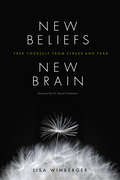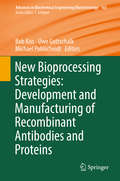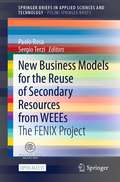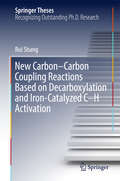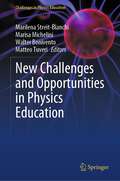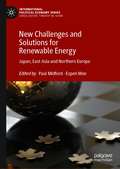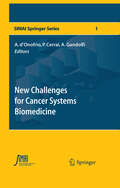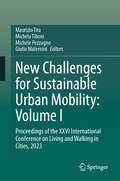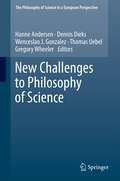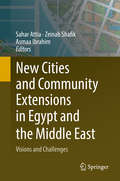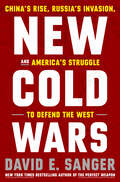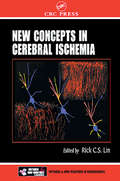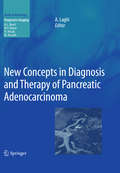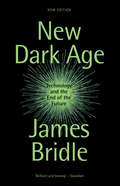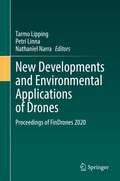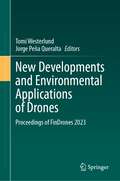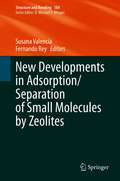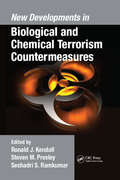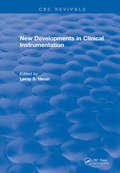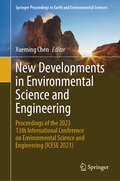- Table View
- List View
New Beliefs, New Brain
by David Perlmutter Lisa WimbergerStress is a silent killer that contributes to heart attacks, strokes, high blood pressure, depression, and suicide. Drawing from her own history with trauma and her experience in working with first responders and others in high stress occupations, Lisa Wimberger teaches powerful meditation practices that will improve the mental and emotional quality of life for those who are suffering. These techniques can be used at any time to turn back the body's clock, regenerate the mind, break negative patterns, and heal emotional wounds. Foreword by David Perlmutter, author of the # 1 bestselling Grain Brain.
New Bioprocessing Strategies: Development and Manufacturing of Recombinant Antibodies and Proteins (Advances in Biochemical Engineering/Biotechnology #165)
by Uwe Gottschalk Bob Kiss Michael PohlscheidtThis book review series presents current trends in modern biotechnology. The aim is to cover all aspects of this interdisciplinary technology where knowledge, methods and expertise are required from chemistry, biochemistry, microbiology, genetics, chemical engineering and computer science.Volumes are organized topically and provide a comprehensive discussion of developments in the respective field over the past 3-5 years. The series also discusses new discoveries and applications. Special volumes are dedicated to selected topics which focus on new biotechnological products and new processes for their synthesis and purification.In general, special volumes are edited by well-known guest editors. The series editor and publisher will however always be pleased to receive suggestions and supplementary information. Manuscripts are accepted in English.
New Business Models for the Reuse of Secondary Resources from WEEEs: The FENIX Project (SpringerBriefs in Applied Sciences and Technology)
by Paolo Rosa Sergio TerziThis open access book summarizes research being pursued within the FENIX project, funded by the EU community under the H2020 programme, the goal of which is to design a new product service paradigm able to promote innovative business models, to open added value to the vessels and to create new market segments. It experiments and validates its approach on three new concepts of added-value specialized vessels able to run requested services for several maritime sectors in the most effective, efficient, economic valuable and eco-friendly way. The three vessels share the same lean design methodology, IoT tools and HPC simulation strategy: a lean fact-based design model approach, which combines real operative data at sea with lean methodology, to support the development and implementation of the vessel concepts; IT customized tools to enable the acquisition, processing and usage of on board and local weather data, through an IoT platform, to provide business services to different stakeholders; HPC simulation, providing a virtual towing tank environment, for early vessel design improvement and testing. The book demonstrates that an integrated LCC analysis and LCC strategy to guarantee sustainability to vessels concepts and the proper environmental attention inside the maritime industry.
New Carbon–Carbon Coupling Reactions Based on Decarboxylation and Iron-Catalyzed C–H Activation
by Rui ShangThis thesis presents the latest developments in new catalytic C-C bond formation methods using easily accessible carboxylate salts through catalytic decarboxylation with good atom economy, and employing the sustainable element iron as the catalyst to directly activate C-H bonds with high step efficiency. In this regard, it explores a mechanistic understanding of the newly discovered decarboxylative couplings and the catalytic reactivity of the iron catalyst with the help of density functional theory calculation. The thesis is divided into two parts, the first of which focuses on the development of a series of previously unexplored, inexpensive carboxylate salts as useful building blocks for the formation of various C-C bonds to access valuable chemicals. In turn, the second part is devoted to several new C-C bond formation methodologies using the most ubiquitous transition metal, iron, as a catalyst, and using the ubiquitous C-H bond as the coupling partner.
New Challenges and Opportunities in Physics Education (Challenges in Physics Education)
by Marisa Michelini Marilena Streit-Bianchi Walter Bonivento Matteo TuveriThis book is invaluable for teachers and students in high school and junior college who struggle to understand the principles of modern physics and incorporate scientific methods in their lessons. It provides interactive and multidisciplinary approaches that will help prepare present and future generations to face the technological and social challenges they will face. Rather than using a unidirectional didactic approach, the authors - scientists, philosophers, communication experts, science historians and science education innovators - divide the book into two parts; the first part, “Communicating Contemporary Physics”, examines how new physics developments affect modern culture, while the second part, “Digital Challenges for Physics Learning”, covers physics education research using ICT, plus the experiences of classroom teachers and a range of ideas and projects to innovate physics and STEM teaching.
New Challenges and Solutions for Renewable Energy: Japan, East Asia and Northern Europe (International Political Economy Series)
by Paul Midford Espen MoeThis book identifies second stage challenges and opportunities for expanding renewable energy into a mainstay of electricity generation that can replace fossil fuels and nuclear power, comparing Japan with several countries in East Asia and Northern Europe. Environmentally sustainable renewable energy technologies have now overtaken fossil fuel and nuclear technologies in terms of total global investment, and the costs of these technologies and related ones (e.g. storage batteries) are rapidly falling. Yet renewable energy use varies greatly from country to country. Major second stage obstacles to replacing fossil and nuclear-fueled electricity generation include the lack of electricity grid capacity and storage assets. Opportunities and solutions include expanding grids regionally and internationally, building flexible smart grids that offer better demand management, and policies that promote the expansion of storage assets, especially grid batteries and hydrogen. In addition, two key factors – electricity market restructuring through unbundling transmission from electricity generating companies; and electricity market liberalization, especially for retail customers – allow consumers to choose power companies based not only on price, but also on method of generation, especially fossil or nuclear generation versus renewable energy.
New Challenges for Cancer Systems Biomedicine
by Alberto D'Onofrio Alberto Gandolfi Paola CerraiThe future of oncology seems to lie in Molecular Medicine (MM). MM is a new science based on three pillars. Two of them are evident in its very name and are well known: medical science and molecular biology. However, there is a general unawareness that MM is firmly based on a third, and equally important, pillar: Systems Biomedicine. Currently, this term denotes multilevel, hierarchical models integrating key factors at the molecular, cellular, tissue, through phenotype levels, analyzed to reveal the global behavior of the biological process under consideration. It becomes increasingly evident that the tools to construct such complex models include, not only bioinformatics and modern applied statistics, as is unanimously agreed, but also other interdisciplinary fields of science, notably, Mathematical Oncology, Systems Biology and Theoretical Biophysics.
New Challenges for Sustainable Urban Mobility: Proceedings of the XXVI International Conference on Living and Walking in Cities, 2023
by Maurizio Tira Michela Tiboni Michele Pezzagno Giulio MaterniniThis volume is the first of a two-volume set of the Proceedings of the XXVI International Conference on Living and Walking in Cities, held September 6-8 2023 at the University of Brescia, Italy. The LWC International Conference was first organized in 1994 at the Department of Civil and Environmental Engineering of the University of Brescia (IT). This year the LWC Conference has arrived at its XXVI edition. The Conference traditionally deals with the topics of urban mobility and quality of life in urban areas, with a specific focus on vulnerable road users. The LWC Conference allows researchers, experts, administrators, and practitioners to gather and discuss policy issues, best practices, and research findings from different perspectives. The main theme of the 2023 conference was “new challenges for sustainable urban mobility”, and the papers herein address the issue from a multidisciplinary perspective and cover a wide variety of related topics. These books are divided into four topical sections:o Transport Systems and Pedestrian Mobilityo Urban Regeneration through Active Mobilityo Public Transport: New Technologies and Economic Sustainabilityo Safe Mobility in Cities
New Challenges for Sustainable Urban Mobility: Proceedings of the XXVI International Conference on Living and Walking in Cities, 2023
by Maurizio Tira Michela Tiboni Michele Pezzagno Giulio MaterniniThis volume is the second of a two-volume set of the Proceedings of the XXVI International Conference on Living and Walking in Cities, held September 6-8 2023 at the University of Brescia, Italy. The LWC International Conference was first organized in 1994 at the Department of Civil and Environmental Engineering of the University of Brescia (IT). This year the LWC Conference has arrived at its XXVI edition. The Conference traditionally deals with the topics of urban mobility and quality of life in urban areas, with a specific focus on vulnerable road users. The LWC Conference allows researchers, experts, administrators, and practitioners to gather and discuss policy issues, best practices, and research findings from different perspectives. The main theme of the 2023 conference was “new challenges for sustainable urban mobility”, and the papers herein address the issue from a multidisciplinary perspective and cover a wide variety of related topics. These books are divided into four topical sections: o Transport Systems and Pedestrian Mobility o Urban Regeneration through Active Mobility o Public Transport: New Technologies and Economic Sustainability o Safe Mobility in Cities
New Challenges in Organic Electrochemistry
by Tetsuo OsaThis monograph will clearly depict much of the current, leading research into the reactions and properties of organic and bioorganic materials in which electron transfer plays an important role. Organic electrochemistry is increasingly expanding to various interdisciplinary fields and is of major interest to a growing number of researchers and engineers. The contents of this book emphasize the scope of the reaction field at the electrode interface, specifically, electrogenerated active species, new mediatory reactions, and new trends in organic electrochemistry. Many of the results demonstrated in these reports may have broad applications to the development of science and new technologies. The twenty contributing authors are all active researchers in organic electrochemistry, bioelectrochemistry, electrocoordination chemistry, or electroanalytical chemistry.
New Challenges to Philosophy of Science
by Thomas Uebel Wenceslao J. Gonzalez Hanne Andersen Dennis Dieks Gregory WheelerThis volume is a serious attempt to open up the subject of European philosophy of science to real thought, and provide the structural basis for the interdisciplinary development of its specialist fields, but also to provoke reflection on the idea of 'European philosophy of science'. This efforts should foster a contemporaneous reflection on what might be meant by philosophy of science in Europe and European philosophy of science, and how in fact awareness of it could assist philosophers interpret and motivate their research through a stronger collective identity. The overarching aim is to set the background for a collaborative project organising, systematising, and ultimately forging an identity for, European philosophy of science by creating research structures and developing research networks across Europe to promote its development.
New Cities and Community Extensions in Egypt and the Middle East: Visions And Challenges
by Sahar Attia Zeinab Shafik Asmaa IbrahimThis book seeks to push forward the boundaries of current practices and knowledge to embrace innovative solutions, novel approaches, and grounded technologies within realistic comprehension of economic risks and environmental implications. It investigates different scales and situations, various urban forms and morphology, and various localities and totalities. The book presents a platform of recent research, findings, and answers to pressing issues of building new cities and expanding existing ones in the Middle East and Egypt, within their ecological limits, formulating images, architecture, and public spaces to create liveable, working, and productive cities. At the time of transformation, people continue to influence their habitat and beyond. While facing the compelling challenges of the present, innovative development poses itself as an inevitable response to future demands. In socio-economic disparities and environmental crises, innovation necessitates a mode of action to act responsibly in addressing issues in unconventional manners. The production of space becomes a responsibility towards the development of human resources, promoting their needs, capacities, and advancing a decent quality of life.
New Cold Wars: China's Rise, Russia's Invasion, and America's Struggle to Defend the West
by David E. SangerNEW YORK TIMES BESTSELLER • The fast-paced inside story of America&’s plunge into a volatile rivalry with the other two great nuclear powers—Xi Jinping&’s China and Vladimir Putin&’s Russia—from the Pulitzer Prize–winning journalist and bestselling author of The Perfect Weapon &“[A] cogent, revealing account of how a generation of American officials have grappled with dangerous developments in the post-Cold War era . . . vividly captures Washington.&”—The New York Times (Editors&’ Choice)ONE OF NPR&’S BEST BOOKS OF THE YEARFor years, the United States was confident that the newly democratic Russia and increasingly wealthy China could be lured into a Western-led order that promised prosperity and relative peace—so long as they agreed to Washington&’s terms. By the time America emerged from the age of terrorism, it was clear that this had been a fantasy.Now the three powers are engaged in a high-stakes struggle for military, economic, political, and technological supremacy, with nations around the world pressured to take sides. Yet all three are discovering that they are maneuvering for influence in a far more turbulent world than they imagined.Based on a remarkable array of interviews with top officials from five presidential administrations, U.S. intelligence agencies, foreign governments, and tech companies, Sanger unfolds a riveting narrative spun around the era&’s critical questions: Will the mistakes Putin made in his invasion of Ukraine prove his undoing and will he reach for his nuclear arsenal—or will the West&’s famously short attention span signal Kyiv&’s doom? Will Xi invade Taiwan? Will both men deepen their partnership to undercut America&’s dominance? And can a politically dysfunctional America still lead the world?Taking readers from the battlefields of Ukraine—where Russia uses bullets from North Korea and drones from Iran—to the Taiwan headquarters where the world&’s most advanced computer chips are produced and on to tense debates in the White House Situation Room, New Cold Wars is a remarkable first-draft history chronicling America&’s return to superpower conflict, the choices that lie ahead, and what is at stake for the United States and the world.
New Computation Methods for Geometrical Optics
by Psang Dain LinThis book employs homogeneous coordinate notation to compute the first- and second-order derivative matrices of various optical quantities. It will be one of the important mathematical tools for automatic optical design. The traditional geometrical optics is based on raytracing only. It is very difficult, if possible, to compute the first- and second-order derivatives of a ray and optical path length with respect to system variables, since they are recursive functions. Consequently, current commercial software packages use a finite difference approximation methodology to estimate these derivatives for use in optical design and analysis. Furthermore, previous publications of geometrical optics use vector notation, which is comparatively awkward for computations for non-axially symmetrical systems.
New Concepts in Cerebral Ischemia (Frontiers in Neuroscience)
by Rick C.S. LinApproximately half a million Americans suffer brain ischemic episodes every year. These brain strokes are the third leading cause of death in the United States and the number-one cause of permanent disability. Over the past decade, we have made extensive attempts to understand the biological mechanisms that underlie stroke-induced neuronal injury. Providing a detailed description of the techniques and theories employed in both basic and clinical research, New Concepts in Cerebral Ischemia delineates the mechanisms underlying neuronal damage induced by ischemia. The book covers methods to elucidate the pathogenesis of ischemia, technologies used in the design of specific strategies to protect neurons from further injury, and new approaches to treat patients with acute ischemic episodes. It includes methods and therapeutic approaches for neuronal protection against acute and chronic ischemic episodes and describes new animal models for ischemia research including the application of transgenic animals.
New Concepts in Diagnosis and Therapy of Pancreatic Adenocarcinoma
by Andrea Laghi Albert L. BaertThis book adopts a multidisciplinary approach to examine in detail a range of interesting new concepts in the diagnosis and therapy of pancreatic adenocarcinoma. It is divided into three parts. The first part provides an epidemiological and clinical overview of the disease, followed by an update on pathological findings, including new discoveries in the area of molecular biology. The second part, on diagnosis, offers detailed and comprehensive information on the advantages and disadvantages of different imaging techniques, including nuclear medicine and endoscopic ultrasound. The concluding part gives a panoramic overview of the various therapeutic options, from surgery to chemotherapy and palliative approaches based on interventional endoscopy and radiology. This book will be a valuable source of information for clinicians involved in the management of pancreatic adenocarcinoma and for all who are interested in updating their knowledge of the disease, including fellows and senior residents.
New Contribution to the Analysis and Evaluation of Safety Architectures: Scientific Investigation of a Safety Architecture
by Ossmane KriniThe objective of this scientific work is to research, test and develop an approach and design a safety architecture for highly safe, available and autonomous systems with regard to functional safety using degradation concepts. A novel, safety-oriented 4oo6 sensor structure targeting functional safety aspects has been thoroughly scientifically investigated, developed and validated. This Sensor Safety 4oo6 structure represents a major challenge as it integrates innovative approaches to improve system safety. The new safety strategy for autonomous systems enables operation in different modes and offers flexibility and adaptability. The 4oo6 safety architecture analyzed and developed in the scientific study has a self-monitoring structure that enables early detection of faults. This ensures that both the safety and availability of the system are maintained in the long term. The new Safety 4oo6 structure represents a new challenge, as such an architecture does not yet exist in the IEC 61508 safety standard or in DIN EN 61511. With this new architecture, a significantly higher level of safety and availability can be achieved.
New Dark Age: Technology and the End of the Future
by James BridleAs the world around us increases in technological complexity, our understanding of it diminishes. Underlying this trend is a single idea: the belief that our existence is understandable through computation, and more data is enough to help us build a better world. In actual fact, we are lost in a sea of information, increasingly divided by fundamentalism, simplistic narratives, conspiracy theories, and post-factual politics. Meanwhile, those in power use our lack of understanding to further their own interests. Despite the accessibility of information, we’re living in a new Dark Age. From rogue financial systems to shopping algorithms, from artificial intelligence to state secrecy, we no longer understand how our world is governed or presented to us. The media is filled with unverifiable speculation, much of it generated by anonymous software, while companies dominate their employees through surveillance and the threat of automation. In his brilliant new work, leading artist and writer James Bridle excavates the limits of technology and how it aids our understanding of the world. Surveying the history of art, technology, and information systems, he explores the dark clouds that gather over our dreams of the digital sublime.
New Developments and Environmental Applications of Drones: Proceedings of FinDrones 2020
by Tarmo Lipping Petri Linna Nathaniel NarraThis volume presents the conference proceedings from FinDrones2020. The book highlights recent developments in drone technology by experts, academicians, and entrepreneurs for applications in agriculture, forestry, and other industries. Emphasis is placed on contextualizing the conference presentations and content to Finland and the unique challenges typical to this region. The work will be of interest to academicians and professionals involved in remote sensing applications of unmanned aerial vehicles, as well as enthusiasts of drone technological developments.
New Developments and Environmental Applications of Drones: Proceedings of FinDrones 2023
by Tomi Westerlund Jorge Peña QueraltaThis volume presents the conference proceedings from FinDrones 2023. The book highlights recent drone technology developments by experts and academicians for applications in agriculture, forestry, and other industries. This iteration of FinDrones presents research using autonomous drones in various fields from environmental monitoring to farm robotics and from photogrammetry to search and rescue missions. Emphasis is placed on contextualizing the conference presentations and content to Finland and the unique challenges typical to the region. The work will interest academicians, entrepreneurs, and professionals involved in remote sensing applications of unmanned aerial vehicles and enthusiasts of drone technological developments.
New Developments in Adsorption/Separation of Small Molecules by Zeolites (Structure and Bonding #184)
by Susana Valencia Fernando ReyThis volume compiles and discusses the fundamental and multidisciplinary knowledge on adsorption and separation processes using zeolites as adsorbents. Over the last decade, a large amount of research has been carried out for the development of zeolites as adsorbents. However, there is still a growing interest to increase the understanding of such selective adsorbents. Therefore, synthesis strategies and new approaches for developing new selective zeolite adsorbents for gas separation are presented in the first chapter. In addition, a chapter focused on adsorption characterization techniques of microporous materials is included. This will be helpful for advanced readers, since the new IUPAC recommendations for microporous characterization are not still widely employed by the zeolite community. Experimental and theoretical aspects of economically and environmentally relevant separations, which have been successfully carried out with zeolites, are discussed in detail in subsequent chapters. Finally, industrial zeolite based adsorption and separation processes as well as current perspectives for new zeolite based separations, and improvements of current technologies are presented.
New Developments in Biological and Chemical Terrorism Countermeasures
by Ronald J. Kendall; Steven M. Presley; Seshadri S. RamkumarA science-based text, New Developments in Biological and Chemical Terrorism Countermeasures presents research that addresses the growing threat of chemical and biological terrorism as well as the need for improvements in the implementation of countermeasures. This new textbook building upon Advances in Biological and Chemical Terrorism Countermeasu
New Developments in Clinical Instrumentation
by Leroy HershThis book has information regarding the new developments in clinical instrumentation, focusing on fluorometers and densitometers, explaining the principles, the use of high performance liquid chromatography in clinical laboratories. Automated Microbiology; dabbling into detection, light scanning and analysis of particles. Amore recent aspect of automation has been, made possible by the advent of the microprocessor orcomputer-on-a-chip. The development of miniature, inexpensive micro-computers has resulted in the automation for relatively sophisticated processes. The two aspects of automation are represented in this monograph. The automated control of physical processes, and automation of the information processing. There are elements of both aspects of automation in this book. The areas discussed do emphasize more or less strongly either tight automated control of physical processes or automation of information processing. They all represent the attempt of medical technology to yield more precise, accurate, less expensive and faster to acid in the clinical diagnosis.
New Developments in Discrete Dynamical Systems, Difference Equations, and Applications: 28th ICDEA, Phitsanulok, Thailand, July 17-21, 2023 (Springer Proceedings in Mathematics & Statistics #485)
by Saber Elaydi Laura Gardini Wirot TikjhaThis compelling book presents remarkable contributions from esteemed speakers who participated in the 28th International Conference on Difference Equations and Applications, ICDEA 2023, hosted at Phitsanulok, Thailand, in collaboration with the International Society of Difference Equations (ISDE) from July 17 to 21, 2023. Embark on an enriching journey through the realms of difference equations and discrete dynamical systems, with practical applications spanning economics, engineering, biology, and related sciences. Immerse yourself in cutting-edge research as you explore new and significant breakthroughs within the fields of difference equations and discrete dynamical systems. This comprehensive compilation spans diverse scientific disciplines, demonstrating the profound impact of these theories and methodologies in practical and tangible settings. From economic modeling to engineering optimization, from biological systems to interdisciplinary applications, this book exemplifies the versatility and relevance of difference equations and discrete dynamical systems. Designed to resonate with a wide audience, including Ph.D. students, researchers, educators, and practitioners, it goes beyond mere dissemination of recent results. It actively fosters the advancement of knowledge, serving as a catalyst for further explorations and innovations across the spectrum of sciences.
New Developments in Environmental Science and Engineering: Proceedings of the 2023 13th International Conference on Environmental Science and Engineering (ICESE 2023) (Springer Proceedings in Earth and Environmental Sciences)
by Xueming ChenThis book contains the peer-reviewed papers that were accepted and presented at the 2023 13th International Conference on Environmental Science and Engineering (ICESE 2023), held in Leuven, Belgium, September 8–10, 2023. The conference provides a forum for researchers and practitioners to address advances in the field of environmental science and engineering including problems, solutions, and research directions. The contents of the book cover emerging and diverse topics, including environmental systems approach, clean technologies, environmental restoration and ecological engineering, wastewater and sludge treatment, climate and climatic changes, atmospheric modeling and numerical prediction, waste minimization, recycling and reuse, solid waste management, carbon capture and storage, and sludge treatment and reuse.
